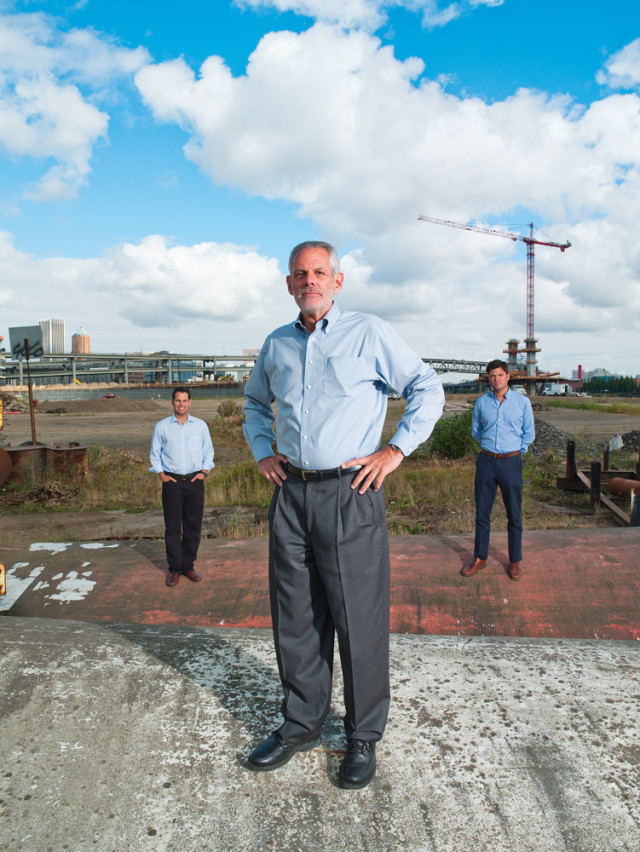Barging Ahead

Jay Zidell, with Dennis Allen (left) and Matt French near the Ross Island Bridge
Image: Stuart Mullenberg
Back in heady 2006, the new aerial tram and the expanding streetcar began their first runs to the glassy Oz known as South Waterfront. The John Ross, a 31-story landmark to the boom years, rose above the new district, boasting an elliptical penthouse (and its 360-degree view) available for a mere $4 million.
Meanwhile, the area’s biggest, oldest property owners, the Zidells, kept doing what they had done for 50 years: building barges—that year, a 365-footer, their largest ever. As their neighbors raked in condo cash, the Zidells’ swath of riverfront land remained polluted with industrial toxins. They had never developed anything more complicated than a warehouse, yet didn’t want to sell. “I don’t know whether to feel anger or envy,” said CEO Jay Zidell at the time, as he watched the surrounding land turn into towers and profits.
Six years later, the 64-year-old, third-generation leader of Zidell Marine may himself inspire envy in a post-bubble economy. (That John Ross penthouse? Sold for $1.5 million.) The barge builders are about to unveil a bold master plan for the 33 acres they own flanking the Ross Island Bridge. An architecturally muscular apartment building is scheduled for a September groundbreaking. And they could be on the cusp of landing a trophy tenant: the tony Pearl District wealth management firm M Financial. All told, the project could be the boldest urban addition the central city will see this decade.
“This is the largest undeveloped piece of real estate in the city,” says Zidell of the land, where the family enterprise just voluntarily conducted a $20 million environmental cleanup. “And it’s all under one family’s control. Few people have the opportunity to impact the city in the way we will be able to.”
With TriMet’s new Milwaukie light-rail line opening to the north and OHSU’s mammoth Collaborative Life Sciences Building rising to the west, the property occupies a sweet spot. But the family’s awakening represents a long, stunning turnabout. Jay Zidell not only sat out South Waterfront’s halcyon days, but was often regarded as an obstacle to the district’s flowering, as his representatives sparred with the city over its planning vision.
Now, the Zidells seem determined to step into the spotlight, with a plan that both lays out a vision of a place unlike any other in town and keeps the barge-building operation right where it is for the foreseeable future. “Sometimes, to do something great you have to break the boundaries of historic thinking,” Zidell said in a recent interview. Other driving forces behind this change include his nephew, Matt French, a 28-year-old USC business school grad and hotel developer from LA—“the fourth generation,” Zidell boasts. In turn, French hired 39-year-old Dennis Allen, an LA developer and, until his move here, the head of that city’s effort to build a $125 million downtown streetcar.
Lunching on a summer day with his nephew at the Pearl District’s Sinju, Zidell became dazzled by the people-filled fountain at Jamison Square. “Let’s find out who designed it,” he said. Enter renowned landscape architect Peter Walker, best known for co-designing New York’s 9/11 Memorial. Early in the process, Walker and his team inspired a vision rich with public spaces and parkland. The big-wheel local architecture firm Zimmer Gunsul Frasca then stepped in to craft a master plan that tosses out both Portland’s traditional grid of 200-foot blocks and the towers that defined South Waterfront in favor of curving, meandering streets and industrial-chic low- and midrise office buildings, housing, micro-retail, and parks, à la Vancouver’s Granville Island.
Master plans are often just marketing fantasies. Netting M Financial, however, would put a catalytic fact on the ground. In a private competition, the Zidells’ young team beat out two veteran developers, Gerding Edlen and TMT Development. According to M Financial broker Ramona Harrington, a decision will come soon; the company will either remodel its Pearl District digs or move to South Waterfront. “They are looking for innovative, collaborative space,” Harrington says, “and they’re not afraid to break new ground.”
The big challenges, of course, are yet to come. (Not least: negotiating with the city over who will pay for streets, pipes, and parks.) “They’re doing the fun stuff now,” one veteran developer sniffs. But French believes his family is poised to tap a new market of car-free young workers “who want to bike 10 miles at lunch without crossing a street.” If the pace proves slow, that’s OK with him: the Zidells still have plenty of orders for new barges.
“We plan to continue holding an interest in this land,” French says. “Our horizon is different than other developers’.”



